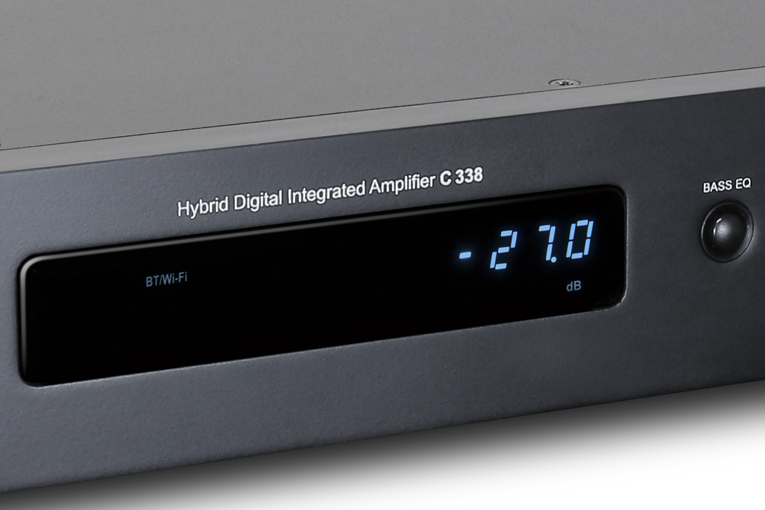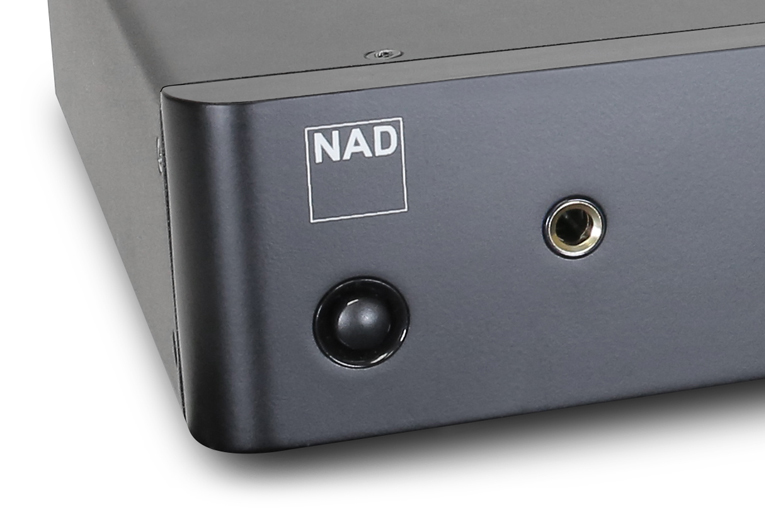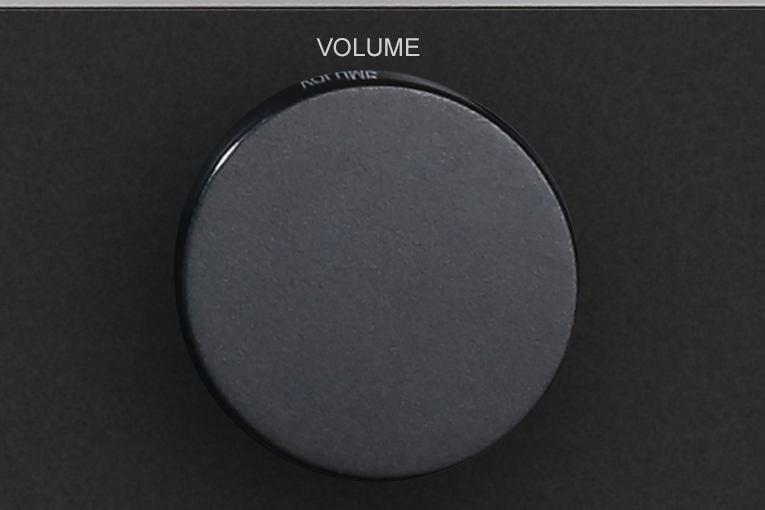 NAD has produced well-regarded amplifiers for more than 40 years, and for most of that time, owing to their need to dissipate copious amounts of heat, amplifiers have shared some basic physical attributes. But when I unboxed the C 338 ($649 USD), and before I saw its rear panel, it looked more like a CD player than an amplifier. While my NAD C 356BEE is covered on top and sides with vents, the smooth surfaces of the C 338’s case are unperforated. It’s also less than half the height of most integrated amps, but reassuringly dense, with a solid cabinet of black steel similar to those enclosing most NAD amps. The C 338, C 368 (recently reviewed by Al Griffin on SoundStage! Simplifi), and C 388 comprise NAD’s newest line of integrated amplifiers, and all include network features. The C 338 is further distinguished by being the first hi-fi amp to have Chromecast built-in (more about this below). It comes with a small remote control, an IEC power cord, three antennas, and two quick-start sheets (the full owner’s manual is available only online).
NAD has produced well-regarded amplifiers for more than 40 years, and for most of that time, owing to their need to dissipate copious amounts of heat, amplifiers have shared some basic physical attributes. But when I unboxed the C 338 ($649 USD), and before I saw its rear panel, it looked more like a CD player than an amplifier. While my NAD C 356BEE is covered on top and sides with vents, the smooth surfaces of the C 338’s case are unperforated. It’s also less than half the height of most integrated amps, but reassuringly dense, with a solid cabinet of black steel similar to those enclosing most NAD amps. The C 338, C 368 (recently reviewed by Al Griffin on SoundStage! Simplifi), and C 388 comprise NAD’s newest line of integrated amplifiers, and all include network features. The C 338 is further distinguished by being the first hi-fi amp to have Chromecast built-in (more about this below). It comes with a small remote control, an IEC power cord, three antennas, and two quick-start sheets (the full owner’s manual is available only online).

On the front panel, which tapers slightly inward toward the top, are buttons for Power/Standby, Source, and Bass EQ, along with a large, unindexed volume knob and a headphone jack. At the center is an LCD screen that displays the source selected, the volume level (in negative dB), and whether the bass equalization is in circuit. The screen has three levels of brightness, and can be turned off entirely; the dB level is displayed in a larger font for a few seconds after the C 338 has been powered up or been adjusted, then disappears. The two Source buttons on the front panel and the remote merely cycle through all available sources; there’s no way to directly select a given source component. The source is always displayed, but in a font too small for me to read from my listening chair -- I’d prefer a larger font.
NAD explains their Bass EQ: “Because we expect this amplifier will often be used with smaller speakers that have limited bass extension, we have brought back NAD’s Bass EQ feature, a low Q filter centered on 80Hz with about 7dB of boost. This gives just the right amount of ‘heft’ to small bookshelf speakers without adding chesty coloration to male voice. It also attenuates infrasonic response to avoid overdriving small woofers.”
The three antennas -- for 5GHz and 2.4GHz Wi-Fi, and Bluetooth -- protrude from the rear panel, but there is no Ethernet port. There are seven inputs: two coaxial, two optical, two line-level, and phono (moving magnet). All digital inputs support resolutions up to 24-bit/192kHz. Interesting is the absence of a USB input, which is what I most often use for music. Outputs are provided for a pair of speakers and a powered subwoofer. The subwoofer output’s crossover frequency is 100Hz and is not adjustable. Like other NAD amplifiers, the C 338’s continuous output of 50Wpc can be delivered into 8- or 4-ohm loads across the audioband with minimal distortion. The frequency response is specified as 20Hz-20kHz, +/-0.3dB.

NAD says this about the C 338’s DAC: “We use a 114dB dynamic range Cirrus Logic DAC [CS4382]. Interestingly, we borrowed a technique we used in Masters Series using Dual Differential topology. This is usually accomplished using two stereo DACs per channel. Here, to stay within budget, we use an eight-channel DAC that is commonly used in high end AVRs, and configure it for stereo use. This pushes performance close to state-of-the-art.”
After 20 minutes without any user input or audio signal, the C 338 automatically switches to standby mode. An alternative mode, called Network, can be configured to permit network and Bluetooth connections to be maintained in standby, at the cost of slightly higher power consumption. The small remote-control handset is minimal but contains all of the C 338’s critical functions -- it’s not a universal model. I appreciated that the remote could be used to dial in attenuation in 0.5dB increments, but its field of operation was rather narrow. Being a network amplifier, the C 338 is compatible with NAD’s free Remote app for Android and iOS. This does offer direct selection of sources, but is fundamentally a reproduction of the physical remote, apart from the odd omission of streaming-playback control buttons. The C 338 is included in the Logitech Harmony database, which opens up possible integration of it with Alexa and other platforms.
Hybrid Digital
While I have a turntable connected to my integrated amplifier, most of my listening is to digital sources, whether files or discs. The traditional solution has been to add an external DAC or build one into the amplifier. In my NAD C 356BEE, the DAC is contained in a removable module (another alternative is a phono-stage module). However, if most of what a buyer will listen to is of digital origin, they can buy an integrated amp optimized for that, and NAD has made that easier. In 2009, they released the well-received Masters Series M2 integrated amplifier, which they described as “a DAC that amplifies.” This Direct Digital technology, which uses a fully digital signal path from input to output and digitizes the signals from analog inputs, was then incorporated into several other NAD models.

For the Hybrid Digital series, NAD included technology from the Dutch firm Hypex Electronics, which takes a different approach that NAD describes in a white paper: “Unlike Direct Digital, which starts with a digital signal and uses active digital processing to perform error correction, the UcD [Universal class D] concept is a switching analogue amplifier with all parameters highly optimized to allow self-regulation.” The design makes possible reduced distortion throughout the audioband. Analog signals remain analog and digital signals remain digital. Volume is digitally controlled but remains in the analog domain. NAD offers three Hybrid Digital amplifiers -- the C 338, C 368, and C 388 -- which vary in power from 50 to 150Wpc. They have no capacitors in the forward signal path and are DC coupled from input to output. NAD’s Asymmetrical PowerDrive promises to optimize available power by more efficient distribution, controlling the power envelope. With a well-regulated power supply, the resulting sound would be detailed, neutral, and nonfatiguing at high volumes without requiring a high consumption of power.
Chromecast and Google Cast
In 2013, Google announced a media-streaming protocol named Google Cast and a digital media player, Chromecast, that supports it. Streams to Google Cast receivers originate from mobile and Web apps (sender apps), or as a screen-mirroring technology from the Google Chrome Web browser using the Cast extension and running on a computer. Receiver apps running on devices are essentially Chrome Web browsers without the graphical user interface; they natively support HTML5 content, but are extensible to a variety of other protocols. Audio codecs supported include AAC, MP3, Vorbis, LPCM, and, critically for our readers, FLAC. Unlike competing technologies such as Apple AirPlay, Cast-enabled apps hand off a stream so that it flows directly from server to receiver. In a typical example, one would initiate playback in the Spotify app on a smartphone, press the Cast button, select a receiver such as the Chromecast dongle, and the stream would then be sent from Spotify’s servers to the playback device. Apart from its role as a remote control, the phone is removed from the process, making it available for other tasks and preserving its battery charge.
Google Cast has since been built into Nexus Player, Android TV, and third-party devices. At the 2017 Consumer Electronics Show the technology was featured in Haier TVs, JBL speakers, Pioneer AVRs, and Sony soundbars, among other products. Similarly, app support had grown from the four at launch -- Google Play Movies & TV, Google Play Music, Netflix, and YouTube -- to over 20,000 titles by 2015. In that year, Google reported that 30 million Chromecasts had been sold and 1.5 billion stream requests delivered. Later in 2015, the Chromecast Audio device (which packs an AKM AK4430 DAC) became especially interesting when an update enabled 24-bit/96kHz playback -- when initially released, the device converted all audio to 48kHz -- and multiroom playback, presenting a challenge to Sonos. NAD’s implementation supports up to 192kHz.
Setting up Chromecast on the NAD C 338 was surprisingly easy. Over the years, I’ve noticed how much easier to set up are integrated amplifiers than audio/video receivers -- assuming the loudspeakers are properly positioned. I installed the Google Home app (Android) and walked through its instructions, making a connection between my phone and the C 338 to pass on the Wi-Fi router credentials and my accounts, and then connecting to media.
One complaint I’ve had about Google’s own Chromecast devices has been the need to use an app for such basic functions as Play, Pause, Skip, etc. While an app is essential for managing large music libraries and playlists, I’ve wanted a simple physical remote to be able to skip a track without unlocking my phone. This has long been possible with the Google Cast SDK through its support of HDMI CEC, but unlike Apple and Amazon, Google has continued selling their streamer without a remote control. The C 338 resolves this problem by including the playback transport control buttons on the remote control.
Sound
I began by playing CDs in my Music Hall MMF CD-25 CD player. Large-scale orchestral works can contain wide dynamic range and a multiplicity of sounds rarely heard in other genres of music. The C 338 exuded a sense of space and a large soundstage. Despite the competing lines, none were lost in the mix as solo instruments, particularly woodwinds, emerged from the wall of sound constituting the first movement of Mahler’s Symphony No.6, in the recording by the Philharmonia Orchestra led by Benjamin Zander (CD layer, Telarc 3SACD-60586). I liked the tonality of NAD’s DAC -- soaring upper-string passages in this somewhat bright recording were presented without becoming saccharine. My CD player’s DAC rendered this passage as a tad bright and brittle. When I switched albums, I noticed a problem: When I loaded a new CD, the optical signal dropped. During this time -- maybe half a second -- the C 338 emitted white noise through the speakers. Other DACs, such as the one in my NAD C 356BEE ($900), did not do this when connected to the same CD player.
The individual instruments in the small ensemble on Anat Cohen’s Notes from the Village were crisp and clean (CD, Anzic ANZ-1302). In the drum solo in “Washington Square Park,” drum resonances were naturally formed. The overall sound was smooth, but at the cost of a bit of detail, especially in the piano in “Until You’re in Love Again.” Guitar passages were open and airy, with rich overtones. Imaging revealed a soundstage broad and deep. NAD’s Bass EQ punched up the drums and bass, pushing them toward the front of the soundstage, but was a bit too boomy for my taste with this largely acoustic music.
Even with Bass EQ off, rock punched through. “New Year’s Day,” from U2’s The Best of 1980-1990 (CD, Island 314-524 613-2), has an energetic, guitar-driven pulse, but the subtle vocals get a bit lost in the mix. Through the NAD it was smooth and laid-back, with good control, and guitar tones were well rounded. The C 356BEE, with NAD’s own with MDC DAC 2.0 digital-to-analog converter, offered more energy, control, and separation to make the mix clear and the voices punch through, but the C 338 had a more natural tone. After living with the C 338, I now found the C 356BEE too bright on some string motifs.

The C 338’s built-in MM phono stage is an oddity in a component with Bluetooth and Wi-Fi. In “Yeye,” from Mongo Santamaria’s Yambu (LP, Fantasy F-8012/OJC 276), timbales and conga drumstrokes were resonant. Voices were centered, but the overall soundstage was a bit shallow. In “Congobel” there were no sibilants from the triangle, and the strokes on various regions of the conga’s skin were distinctive. When I switched to an outboard phono stage, a Cambridge Audio 540P, there was perhaps 3dB more gain, more separation, cleaner-sounding voices, and a deeper soundstage, but less character in the sound of each drum, particularly in the decays. The C 338’s built-in phono stage is perfectly serviceable, and appreciated for source completeness. Few would need to upgrade, unless a large share of listening were done from LPs. For me, LPs are only an occasional source.
Turning to what makes the C 338 unique, I found it much less picky about which FLACs it would play than Google’s own Chromecast Audio device. I tried playing 44.1, 88.2, 96, 176.4, and 192kHz FLACs from various sources -- some I converted myself, but most were from 2L, eClassical, and HDtracks -- streamed via the DS Audio app on Android from my Synology NAS. The C 338 played them all; Chromecast Audio refused to play most. In fact, I found it necessary to recompress FLACs to particular bitrates -- compression Level 5 with dBpoweramp, and Level 0 with JRiver Media Center -- before the Chromecast Audio would behave. I had thought this was a problem with the Chromecast technology, but it turned out to be just Google’s shoddy device implementation. But the C 338 just worked. It had to do a bit of buffering when beginning to play a 24/176.4 or 24/192 file on my 2.4GHz Wi-Fi network, but this was resolved in seconds. Still, I wish NAD had included an Ethernet port.
Alison Krauss’s sublime, delicate voice emerged from the mix with natural clarity and presence in “Sister Rosetta Goes Before Us,” from her and Robert Plant’s Raising Sand (24/96 FLAC, Rounder/HDtracks), streamed from my NAS. Motifs fluidly passed among the instrumental voices. In “Shattering Sea,” from Tori Amos’s Night of Hunters (24/88.2 FLAC, Deutsche Grammophon/HDtracks), a wall of piano and string sound recedes, leaving only her distinctive piano and voice. Vocal phrases were airy, while Amos’s left-hand piano themes were energetic. The tight ensemble work of the piano and strings conveyed intensity and excitement. The Great Gate at Kiev from Pictures at an Exhibition, with Peter Breiner conducting the New Zealand Symphony Orchestra in his own orchestration of Mussorgsky’s original version for solo piano (24/96 FLAC, Naxos/HDtracks), demonstrated open, rounded, resonating bell tones in full, uncongested sound and warm, enveloping swells.

I found myself making much more use of my Google Play Music subscription than ever -- the C 338 made it so easy and satisfying. I heard Norwegian trumpeter Tine Thing Helseth, and recognized in her recording of concertos by Albinoni, Haydn, Hummel, and Neruda (256kbps MP3, Simax Classics/Google Play Music) her light touch, with just enough air to fill the hall without ever seeming forced, that I’d heard from her in concert at the 2015 Cabrillo Festival of Contemporary Music. The C 338 communicated the essence of her style in the Haydn with graceful interplay between the soloist and the Norwegian Chamber Orchestra (in this concerto led by Terje Tønnesen). In the first-movement cadenza, it reproduced Helseth’s wide dynamic range and clarity of tone. Of course, only so much can be done with compressed streaming services, but the C 338 provided as good an experience as I’ve enjoyed with high-bitrate MP3s.
Value and wrap-up
Going in, I wondered if the Google Chromecast built into NAD’s C 338 would provide no more than a more seamless variant of the $35 Chromecast dongle Google sells. It was indeed seamless -- and more. NAD has made Chromecast easier to use, more flexible, and sound better. In fact, so remarkable is NAD’s implementation that I wish they’d sell a Chromecast box as a separate source. The C 338 is filled out with an impressive, natural-sounding DAC, and an amplifier section that should easily fill most rooms. The NAD C 338 is an excellent value, especially for those interested in using Chromecast.
. . . Sathyan Sundaram
sathyans@soundstagenetwork.com
Associated Equipment
- Speakers -- Sonus Faber Principia 3 and Principia C; Wharfedale Diamond 8.2, Diamond 8 Centre, PowerCube 10 subwoofer; Infinity Primus P162; M-Audio Studiophile DX4
- Headphones -- Grado SR80, Shure E3
- Analog sources -- Goldring GR1 turntable, Rega Research RB100 tonearm, Goldring Elektra cartridge; Cambridge Audio 540P phono preamplifier; Onkyo TA-RW244 tape deck
- Digital sources -- Music Hall MMF CD-25 CD player; Pioneer DV-563A DVD/SACD/CD player; Google Chromecast Audio; Raspberry Pi2 running Volumio 2; Monoprice HDX-401TA; NAD MDC DAC2.0 DAC
- Subscription services -- Google Play Music All Access (via Chromecast Audio)
- Integrated amplifier -- NAD C 356BEE
- Power conditioner -- APC Line-R LE1200
NAD C 338 Hybrid Digital Wireless Streaming DAC-Integrated Amplifier
Price: $649 USD.
Warranty: Two years parts and labor.
NAD Electronics International
633 Granite Court
Pickering, Ontario L1W 3K1
Canada
Phone: (905) 831-6555
Fax: (905) 837-6357
Website: www.nadelectronics.com






















